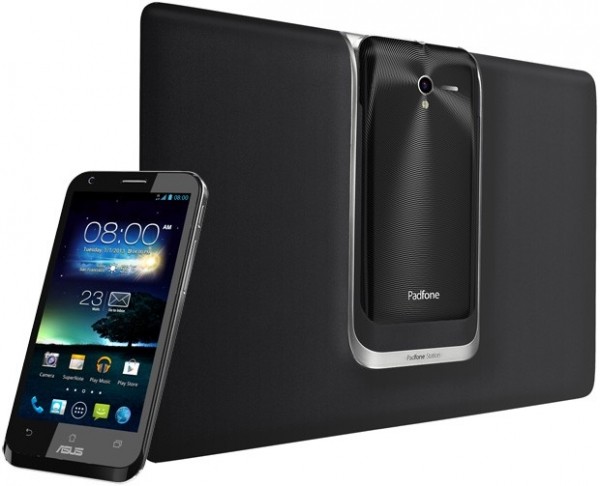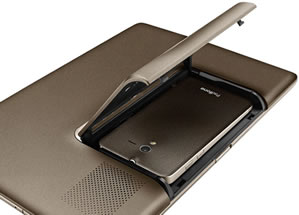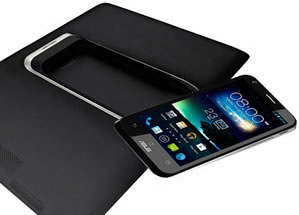We've seen countless attempts at hybridizing tablets and notebooks, but few manufacturers have taken that consolidation to the next step by using a smartphone as a primary computing device that attaches to various accessories that transform the handset into a tablet or laptop. In fact, besides the Motorola Atrix, Asus has made the only memorable attempt in the last year with its first-generation PadFone.
The PadFone was unveiled last spring (check out this video for a few laughs), and although it made a decent impression on reviewers, most folks agreed that the device felt a little unpolished. The package was a tad heavy at about two pounds, the docking mechanism wasn't exactly seamless, the handset's chips were a little sluggish in tablet "mode" and there were some synchronization issues with apps.

It's only been a few months since the first device hit shelves, but Asus has already prepared a follow-up that is lighter, faster and more refined than its predecessor. The PadFone 2's smartphone touts a 4.7-inch Super IPS+ 1280x720 display, a quad-core 1.5GHz Qualcomm Snapdragon S4, 2GB of RAM, and a 2140mAh battery that supplies up 13 hours of browsing over Wi-Fi and 16 hours of talk time.
Meanwhile, the tablet dock provides a 10.1-inch 1280x800 IPS display and a 5000mAh battery for up to 36 hours of talk time (the handset charges when docked and you can use a headset to make calls while it's attached to the tablet). Alone, the phone weighs 135g and that jumps to 649g (1.43lbs) when combined with the slate, or less than the current-gen iPad. Here's a comparison of both PadFones:
| PadFone 1 Phone | PadFone 2 Phone | PadFone 1 Dock | PadFone 2 Dock | |
| Display | 4.3" 96x540 Super AMOLED | 4.7" 1280x720 Super IPS+ | 10.1" 1280x800 TFT | 10.1" 1280x800 IPS |
| Processor | Dual-Core 1.5GHz Snapdragon S4 | Quad-Core 1.5GHz Snapdragon S4 | N/A | N/A |
| Memory | 1GB of RAM | 2GB of RAM | N/A | N/A |
| Storage | 16 to 64GB eMMc Flash, 32GB of cloud storage | 16/32/64GB integrated storage, 50GB of cloud storage | N/A | N/A |
| Battery | 1520mAh/8hrs 3G talk | 2140mAh/16hrs 3G talk | 6600mAh | 5000mAh |
| Camera | VGA (640x480) front, 8MP LED flash back | 1.2MP front, 13MP (1080p@30fps) back | 1.3MP front | ?? |
| Wireless | 2G, 3G, Wi-Fi, Bluetooth | Adds NFC and LTE | N/A | N/A |
| Other | microSD, e-compass, gyroscope, light/motion sensor etc. | Drops the microSD expansion slot | micro-USB, micro-HDMI, phone/GPS antennas, speakers, 3.5mm audio jack | ?? |
| Size | 128x65.4x9.2mm, 129g | 137.9x69x9mm, 135g | 273x176.9x13.55mm, 854g w/ phone | 649g w/ phone (today's 3G iPad is 662g) |
Obviously we're still missing a few details about the PadFone 2 dock's camera and connectivity, but it's probably fairly similar to the original design. Of note, the table doesn't list one of the PadFone 2's greatest improvements, the new docking mechanism, which is said to have been in development for several years and simplifies the process of attaching or removing the PadFone to the tablet. Once you pop the handset in, hands-on reports say it takes about a second for the slate to become functional.
Comparison of PadFone 1 & 2 docking methods
Interestingly, word has it that the PadFone 2 won't necessarily directly replace the PadFone. Although it clearly iterates on the original design, the updated model may be offered alongside the older model. Information is spotty, obviously, but it seems that the PadFone 1 has an optional keyboard to transform the tablet into a laptop, while the PadFone 2 may not have this accessory. The PadFone 2 bundle will launch in Europe and Asia by December for €800 (32GB) and €900 (64GB). US availability is unknown.

